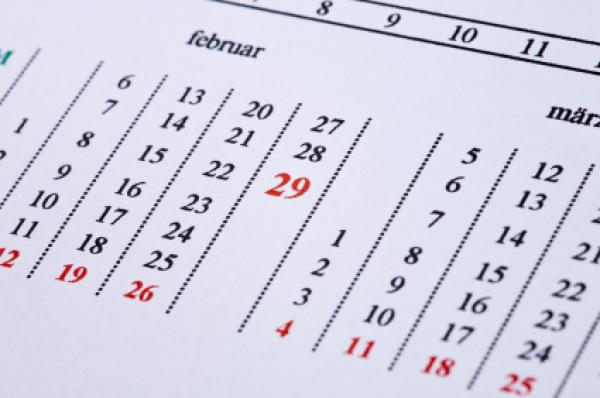The following chart shows the months and how they line up (approximately) with our modern Gregorian calendar.

Israel had two years, a civil year and a religious year (just as we have both a calendar year and a financial year). The civil year started in the month Ethanim (corresponding to our September/October) with the Feast of Trumpets, Day of Atonement and Feast of Tabernacles. The religious year started six months later with the month Abib (also called Nisan) and included the Feasts of Passover, Unleavened bread and Firstfruits. The other major feast was Harvest (also called Pentecost), 50 days after Passover."
By
http://bibleq.net/answer/3578/
"The Gregorian calendar

The Gregorian calendar is the one used in the western world today.
Calendar features
The calendar is strictly a solar calendar based on a 365-day common year divided into 12 months of irregular lengths. Each month consists of either 30 or 31 days with 1 month consisting of 28 days during the common year. A Leap Year usually occurs every 4 years which adds an extra day to make the second month of February 29 days long rather than 28 days.Realigned with the equinox
The Gregorian calendar reformed the Julian calendar because the Julian calendar introduced an error of 1 day every 128 years. The introduction of the Gregorian calendar allowed for the realignment with the equinox, however a number of days had to be dropped when the change was made.The Gregorian calendar was first adopted in Italy, Poland, Portugal and Spain in 1582. The Gregorian reform consisted of the following changes:
- 10 days were dropped in October 1582.
- New rules were set to determine the date of Easter.
- The rule for calculating Leap Years was changed to include that a year is a Leap Year if:
- The year is evenly divisible by 4;
- If the year can be evenly divided by 100, it is NOT a leap year, unless;
- The year is also evenly divisible by 400. Then it is a leap year.
The Julian calendar is currently (between the years 1901 and 2099) 13 days behind the Gregorian calendar because too many Leap Years were added. The Gregorian calendar is off by about 1 day every 3236 years.
Switching to the Gregorian calendar
The Gregorian calendar would not be adopted until much later in Great Britain and America. It wasn’t until September 1752 that 11 days were dropped to switch to the Gregorian calendar.Sweden and Finland had a "double" Leap Year in 1712. Two days were added to February – creating a date of February 30, 1712. This was done because the Leap Year in 1700 was dropped and Sweden's calendar was not synchronized with any other calendar. By adding an extra day in 1712, they were back on the Julian calendar.
Japan replaced its lunisolar calendar with the Gregorian calendar in January 1873, but decided to use the numbered months it had originally used rather than the European names. The Republic of China originally adopted the Gregorian calendar in January 1912, but it wasn’t used in China due to warlords using different calendars. However, the Nationalist Government formally decreed the adoption of the Gregorian calendar in China in January 1929.
Who designed the Gregorian calendar?
Although the Gregorian calendar is named after Pope Gregory XIII, it is an adaptation of a calendar designed by Italian doctor, astronomer and philosopher Luigi Lilio (also known as Aloysius Lilius). He was born around 1510 and died in 1576, six years before his calendar was officially introduced."http://www.timeanddate.com/calendar/gregorian-calendar.html
No comments:
Post a Comment